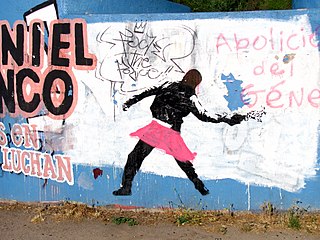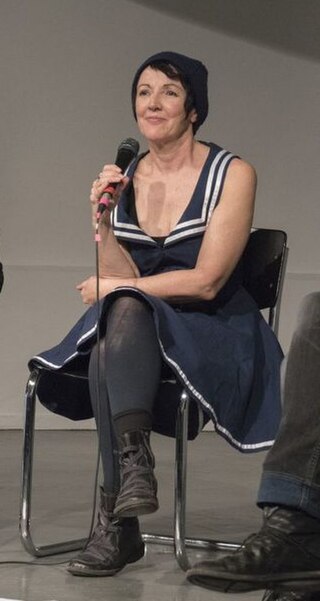
Donna J. Haraway is an American professor emerita in the history of consciousness and feminist studies departments at the University of California, Santa Cruz, and a prominent scholar in the field of science and technology studies. She has also contributed to the intersection of information technology and feminist theory, and is a leading scholar in contemporary ecofeminism. Her work criticizes anthropocentrism, emphasizes the self-organizing powers of nonhuman processes, and explores dissonant relations between those processes and cultural practices, rethinking sources of ethics.

"A Cyborg Manifesto" is an essay written by Donna Haraway and published in 1985 in the Socialist Review (US). In it, the concept of the cyborg represents a rejection of rigid boundaries, notably those separating "human" from "animal" and "human" from "machine." Haraway writes: "The cyborg does not dream of community on the model of the organic family, this time without the oedipal project. The cyborg would not recognize the Garden of Eden; it is not made of mud and cannot dream of returning to dust."
Socialist feminism rose in the 1960s and 1970s as an offshoot of the feminist movement and New Left that focuses upon the interconnectivity of the patriarchy and capitalism. However, the ways in which women's private, domestic, and public roles in society has been conceptualized, or thought about, can be traced back to Mary Wollstonecraft's A Vindication of the Rights of Woman (1792) and William Thompson's utopian socialist work in the 1800s. Ideas about overcoming the patriarchy by coming together in female groups to talk about personal problems stem from Carol Hanisch. This was done in an essay in 1969 which later coined the term 'the personal is political.' This was also the time that second wave feminism started to surface which is really when socialist feminism kicked off. Socialist feminists argue that liberation can only be achieved by working to end both the economic and cultural sources of women's oppression.

Shulamith Bath Shmuel Ben Ari Firestone was a Canadian-American radical feminist writer and activist. Firestone was a central figure in the early development of radical feminism and second-wave feminism and a founding member of three radical-feminist groups: New York Radical Women, Redstockings, and New York Radical Feminists. Within these radical movements, Firestone became known as "the firebrand" and "the fireball" for the fervor and passion she expressed towards the cause. Firestone participated in activism such as speaking out at The National Conference for New Politics in Chicago. Also while a member of various feminist groups she participated in actions including protesting a Miss America Contest, organizing a mock funeral for womanhood known as "The Burial of Traditional Womanhood", protesting sexual harassment at Madison Square Garden, organizing abortion speakouts, and disrupting abortion legislation meetings.
Postmodern feminism is a mix of post-structuralism, postmodernism, and French feminism that rejects a universal female subject. The goal of postmodern feminism is to destabilize the patriarchal norms entrenched in society that have led to gender inequality. Postmodern feminists seek to accomplish this goal through opposing essentialism, philosophy, and universal truths in favor of embracing the differences that exist amongst women to demonstrate that not all women are the same. These ideologies are rejected by postmodern feminists because they believe if a universal truth is applied to all women of society, it minimizes individual experience, hence they warn women to be aware of ideas displayed as the norm in society since it may stem from masculine notions of how women should be portrayed.

Postgenderism is a social, political and cultural movement which arose from the eroding of the cultural, psychological, and social role of gender, and an argument for why the erosion of binary gender will be liberatory.
Faith Wilding is a Paraguayan American multidisciplinary artist - which includes but is not limited to: watercolor, performance art, writing, crocheting, knitting, weaving, and digital art. She is also an author, educator, and activist widely known for her contribution to the progressive development of feminist art. She also fights for ecofeminism, genetics, cyberfeminism, and reproductive rights. Wilding is Professor Emerita of performance art at the School of the Art Institute of Chicago.

Feminist art is a category of art associated with the feminist movement of the late 1960s and 1970s. Feminist art highlights the societal and political differences women experience in their lives. The goal of this art form is to bring a positive and understanding change to the world, leading to equality or liberation. Media used range from traditional art forms, such as painting, to more unorthodox methods such as performance art, conceptual art, body art, craftivism, video, film, and fiber art. Feminist art has served as an innovative driving force toward expanding the definition of art by incorporating new media and a new perspective.
VNS Matrix was an artist collective founded in Adelaide, Australia, in 1991, by Josephine Starrs, Julianne Pierce, Francesca da Rimini and Virginia Barratt. Their work included installations, events, and posters distributed through the Internet, magazines, and billboards. Taking their point of departure in a sexualised and socially provocative relationship between women and technology the works subversively questioned discourses of domination and control in the expanding cyber space. They are credited as being amongst the first artists to use the term cyberfeminism to describe their practice; according to artist Anna Couey they outright coined the term along with Sadie Plant .Their first use of the term cyberfeminist was in 1991.

Cornelia Sollfrank is a German digital artist, she was an early pioneer of Net Art and Cyberfeminism in the 1990s.
subRosa is a cyberfeminist organization led by artists Faith Wilding and Hyla Willis.
Feminist technoscience is a transdisciplinary branch of science studies which emerged from decades of feminist critique on the way gender and other identity markers are entangled in the combined fields of science and technology. The term technoscience, especially in regard to the field of feminist technoscience studies, seeks to remove the distinction between scientific research and development with applied applications of technology while assuming science is entwined with the common interests of society. As a result, science is suggested to be held to the same level of political and ethical accountability as the technologies which develop from it. Feminist technoscience studies continue to develop new theories on how politics of gender and other identity markers are interconnected to resulting processes of technical change, and power relations of the globalized, material world.
Julianne Pierce is an Australian new media artist, curator, art critic, writer, and arts administrator. She was a member of the groundbreaking group VNS Matrix. She went on to become a founding member of the Old Boys Network, another important cyberfeminist organisation. She has served as executive director of the Australian Dance Theatre and is Chair of the Emerging and Experimental Arts Strategy Panel for the Australia Council. Pierce was executive director of the Australian Network for Art and Technology (ANAT) from 2000 to 2005, based in Adelaide, and was Executive Producer of Blast Theory from 2007 to 2012, based in Brighton in the UK.
Chela Sandoval, associate professor of Chicana Studies at University of California, Santa Barbara, is a noted theorist of postcolonial feminism and third world feminism. Beginning with her 1991 pioneering essay 'U.S. Third World Feminism: The Theory and Method of Oppositional Consciousness in the Postmodern World', Sandoval emerged as a significant voice for women of color and decolonial feminism.

For the American jurist, see Nancy Paterson.

Nathalie Magnan was a media theoretician and activist, a cyber-feminist, and a film director. She taught at both universities and art schools, and is known for initiating projects linking Internet activism and sailing with the Sailing for Geeks project. She also co-organised the Los Angeles Gay and Lesbian Film Festival in 1984. She died at home of breast cancer.
Faces is an international online community of women who share an interest in digital media arts. They communicate via an email list and organize events both online and off. Founded in 1997, this informal network includes activists, artists, critics, theoreticians, technicians, journalists, researchers, programmers, networkers, web designers, and educators.

Francesca da Rimini is an Australian artist. With Josephine Starrs, Julianne Pierce, and Virginia Barratt she co-founded VNS Matrix, and the four artists coined the term cyberfeminist in 1991 to describe their art practice. Da Rimini has been working in new media since 1984.
Feminist science and technology studies is a theoretical subfield of science and technology studies (STS), which explores how gender interacts with science and technology. The field emerged in the early 1980s alongside other relativist theories of STS which rejected the dominance of technological determinism, proposing that reality is multiple rather than fixed and prioritizing situated knowledges over scientific objectivity. Feminist STS's material-semiotic theory evolved to display a complex understanding of gender and technology relationships by the 2000s, notable scholars producing feminist critiques of scientific knowledge and the design and use of technologies. The co-constructive relationship between gender and technology contributed to feminist STS's rejection of binary gender roles by the twenty-first century, the field's framework expanding to incorporate principles of feminist technoscience and queer theory amidst widespread adoption of the internet.
Carolyn Guertin is a Canadian artist, scholar, and author. Guertin is known for critical writing related to cyberfeminism, born-digital arts, participatory cultures, theoretical work in emergent media arts and literatures, global digital culture, information aesthetics, hacktivism, tactical media, and the social practices surrounding technology.









